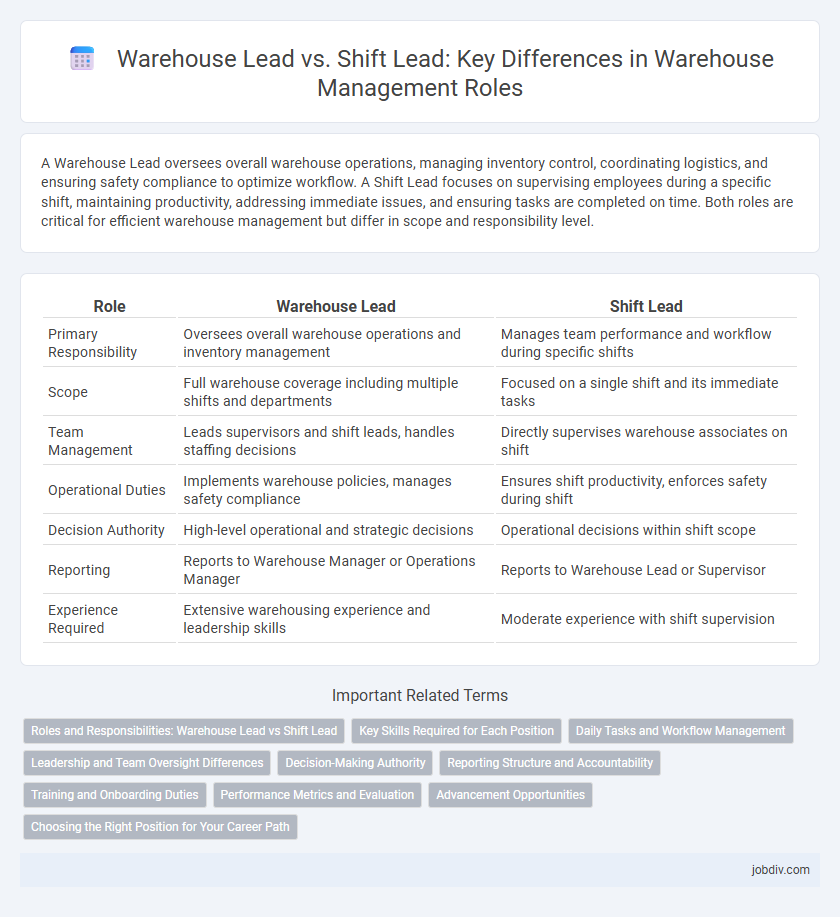A Warehouse Lead oversees overall warehouse operations, managing inventory control, coordinating logistics, and ensuring safety compliance to optimize workflow. A Shift Lead focuses on supervising employees during a specific shift, maintaining productivity, addressing immediate issues, and ensuring tasks are completed on time. Both roles are critical for efficient warehouse management but differ in scope and responsibility level.
Table of Comparison
| Role | Warehouse Lead | Shift Lead |
|---|---|---|
| Primary Responsibility | Oversees overall warehouse operations and inventory management | Manages team performance and workflow during specific shifts |
| Scope | Full warehouse coverage including multiple shifts and departments | Focused on a single shift and its immediate tasks |
| Team Management | Leads supervisors and shift leads, handles staffing decisions | Directly supervises warehouse associates on shift |
| Operational Duties | Implements warehouse policies, manages safety compliance | Ensures shift productivity, enforces safety during shift |
| Decision Authority | High-level operational and strategic decisions | Operational decisions within shift scope |
| Reporting | Reports to Warehouse Manager or Operations Manager | Reports to Warehouse Lead or Supervisor |
| Experience Required | Extensive warehousing experience and leadership skills | Moderate experience with shift supervision |
Roles and Responsibilities: Warehouse Lead vs Shift Lead
Warehouse Leads oversee inventory management, coordinate receiving and shipping processes, and ensure compliance with safety regulations across the entire warehouse. Shift Leads focus on supervising team productivity during specific shifts, managing labor resources, and resolving operational issues in real-time on the floor. Both roles require strong leadership skills, but Warehouse Leads emphasize strategic oversight while Shift Leads prioritize day-to-day operational execution.
Key Skills Required for Each Position
Warehouse Leads require strong organizational abilities, proficiency in inventory management systems, and expertise in coordinating shipping and receiving operations to ensure efficient workflow. Shift Leads emphasize excellent team leadership, real-time problem-solving skills, and effective communication to maintain productivity and address issues during their shifts. Both roles demand a solid understanding of safety protocols, but Warehouse Leads typically focus more on strategic planning while Shift Leads prioritize on-the-floor supervision and immediate decision-making.
Daily Tasks and Workflow Management
Warehouse Leads oversee overall inventory control, coordinate inbound and outbound shipments, and ensure compliance with safety protocols to maintain operational efficiency. Shift Leads manage team productivity during their specific shifts, delegate daily assignments, monitor real-time workflow, and address immediate issues to meet shift goals. Both roles require strong communication skills and the ability to adapt schedules and resources dynamically to optimize warehouse throughput.
Leadership and Team Oversight Differences
Warehouse Leads primarily focus on operational efficiency, overseeing inventory management and order fulfillment processes to ensure smooth warehouse functions. Shift Leads emphasize direct team leadership, managing shift schedules, coordinating personnel workflows, and addressing real-time issues to maintain productivity during their shifts. The key distinction lies in Warehouse Leads driving overall process improvements, while Shift Leads concentrate on immediate team supervision and shift-specific task execution.
Decision-Making Authority
Warehouse Leads oversee daily operations with moderate decision-making authority, focusing on task assignments and resolving immediate workflow issues. Shift Leads hold higher decision-making power, managing overall shift performance, addressing escalated problems, and coordinating resources for efficiency. Both roles ensure operational continuity, but Shift Leads have broader authority to implement strategic adjustments during their shifts.
Reporting Structure and Accountability
Warehouse Leads typically report directly to Warehouse Managers, overseeing overall operational efficiency and inventory accuracy. Shift Leads report to Warehouse Leads or Shift Supervisors, managing specific team performance and ensuring shift-level task completion. Accountability for Warehouse Leads involves strategic decision-making and cross-department coordination, while Shift Leads focus on real-time workflow execution and immediate issue resolution.
Training and Onboarding Duties
Warehouse Leads oversee comprehensive training programs to ensure new employees understand safety protocols, material handling techniques, and company policies, emphasizing operational efficiency and compliance. Shift Leads concentrate on onboarding staff specific to their shift, providing hands-on guidance with task execution and immediate problem-solving to maintain workflow continuity. Both roles prioritize training but differ in scope, with Warehouse Leads focusing on broad organizational standards and Shift Leads delivering shift-specific practical instruction.
Performance Metrics and Evaluation
Warehouse Leads are primarily assessed on inventory accuracy, order fulfillment rate, and safety compliance, ensuring operational efficiency. Shift Leads focus on real-time performance metrics such as labor productivity, adherence to schedules, and issue resolution speed during their shift. Both roles require ongoing performance evaluations using KPIs like on-time shipments and error rates to drive continuous improvement.
Advancement Opportunities
Warehouse Leads typically oversee daily warehouse operations, managing inventory accuracy and team productivity, which provides a foundational platform for advancement into roles such as Warehouse Supervisor or Operations Manager. Shift Leads focus on managing and motivating employees during specific shifts, gaining leadership experience that can lead to positions like Senior Shift Lead or Assistant Manager. Both roles offer vital supervisory experience, but Warehouse Leads often have broader operational responsibilities that enhance prospects for higher-level management careers within warehousing.
Choosing the Right Position for Your Career Path
Choosing between a Warehouse Lead and a Shift Lead depends on your career goals and skill set; a Warehouse Lead typically oversees overall warehouse operations and strategic workflow management, while a Shift Lead focuses on supervising daily shift activities and team coordination. Warehouse Leads often require advanced experience in inventory control, logistics planning, and cross-functional leadership, making it ideal for those aiming for upper management roles. Shift Leads benefit from strong interpersonal skills and real-time problem-solving abilities, positioning themselves as effective frontline supervisors within fast-paced environments.
Warehouse Lead vs Shift Lead Infographic

 jobdiv.com
jobdiv.com